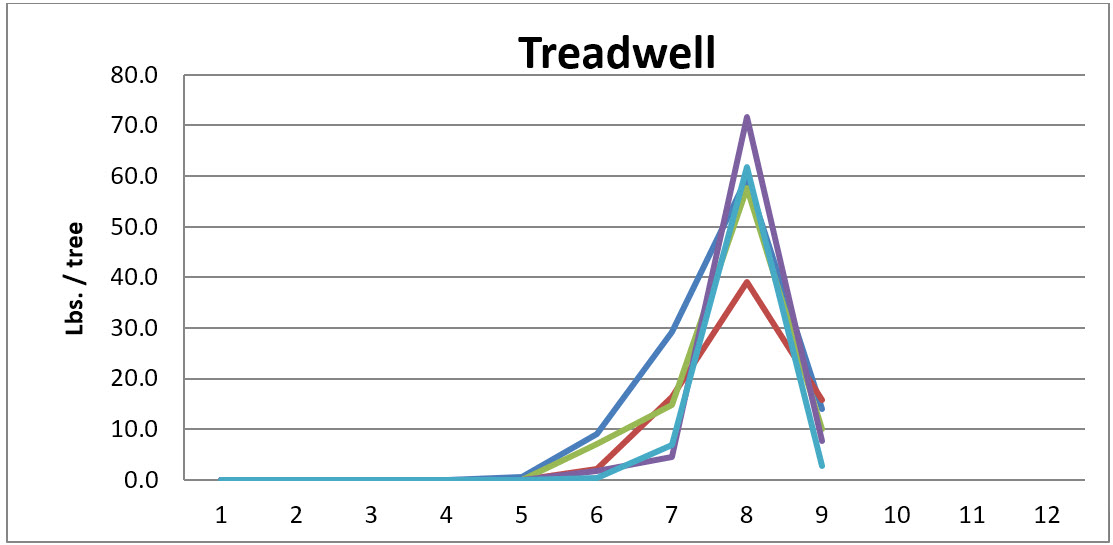Treadwell


History
‘Treadwell’ was released in 2012 by Dr. Darrell Sparks at the University of Georgia. ‘Treadwell’ was originally tested as ‘Selection No. 34’ and originated from the cross ‘Wichita’ x ‘Pawnee’.
Comments
Trees of ‘Treadwell’ were planted along with several early harvest cultivars in 2009. Seedling trees were planted in the early spring of 2009 and then were 4-flap grafted to the scion variety later that same spring. Early yields of ‘Treadwell’ have been good, but uneven. Yields were low until year 8, when the trees overcropped, and then the trees had an off year in year 9. ‘Treadwell’ is a precocious cultivar that will demand crop thinning in order to control alternate bearing beginning at a young age.
Nut quality of ‘Treadwell’ is excellent. We averaged 49 nuts/lb. and 59% kernel so far on our young trees. The kernels shell out well and are very attractive. The one thing about this cultivar that stands out to me is the light golden color that holds very well, the color of this cultivar is much better than its ‘Pawnee’ parent. While not quite as large as ‘Byrd’, it is a prettier kernel. ‘Treadwell’ is an early harvest cultivar, and harvest date is in late September, similar to ‘Byrd’, but after ‘Pawnee’.
Like ‘Byrd’ and ‘Morrill’, ‘Treadwell’ does not have good scab resistance. In our test ‘Treadwell’ has looked similar to ‘Byrd’ and ‘Pawnee’. ‘Treadwell’ should have full season fungicide protection, and should not be planted in scab prone areas. ‘Treadwell’ trees are smaller than many cultivars and may be planted more closely together than some other more vigorous cultivars.
‘Treadwell’ shucks do not open wide, instead they just crack open. In hot, damp harvest periods this can lead to premature germination of the nuts. In order to lessen this, growers should irrigate well up until harvest and should be vigilant in controlling hickory shuck worm so that the shucks open as well as possible.
‘Treadwell’ is a type I, protandrous, with fairly early pollen shed. I think it would be similar to ‘Pawnee’ in pollination pattern. It should match well with ‘Zinner’, ‘Cherryle’, ‘Lakota’, ‘Avalon’, and ‘Elliott’.
‘Treadwell’ is a new cultivar and we are still monitoring its yield and quality. We already know that ‘Treadwell’ will demand crop thinning beginning almost as soon as it begins to bear. No one should plant ‘Treadwell’ if they are not going to control crop load. We also know that ‘Treadwell’ will need a full season of fungicide protection to control scab. If you have trouble with controlling scab in your orchard, I would not plant ‘Treadwell’. If these requirements are met, ‘Treadwell’ produces a very pretty nut, and yields may be very good if they are planted at a higher density.
Table 1. Yield and quality of ‘Treadwell’ over 9 years (2009-2017).
| Cultivar | Avg. Yield | # Nuts / lb. | % Kernel | Cluster Size | 50% Shuck Split |
| lbs./tree/year | |||||
| Treadwell | 10 | 49 | 59% | 2.4 | Sept. 21 |
| Pawnee | 5 | 47 | 56% | 2.1 | Sept. 10 |
Fig. 1. Individual tree yield of ‘Treadwell’ over 9 years (2009-2017). Each line indicates the yield of a separate tree.

Table 2. Average pest resistance of test cultivars in a sprayed orchard 2009-2017.
| Cultivar | Leaf ScabZ | Nut ScabY | Nut Scabx | Black Aphid Damagew |
| Avg. | Avg. | Worst | Avg. | |
| Treadwell | 1.8 | 1.1 | 2.4 | 1.2 |
| Pawnee | 1.8 | 1.0 | 2.7 | 1.1 |
- z1 = no scab lesions, 2 = a few isolated lesions with restricted growth, 3 = multiple lesions with expanding growth, 4 = stem scab lesions or defoliation.
- y1 = no scab lesions, 2 = a few lesions with restricted growth, 3 = multiple lesions, 0% to 10% coverage, 4 = 11% to 50% coverage, 5 = 51% to 100% coverage or nut drop. Average damage seen on nuts over the tree.
- x1 = no scab lesions, 2 = a few lesions with restricted growth, 3 = multiple lesions, 0% to 10% coverage, 4 = 11% to 50% coverage, 5 = 51% to 100% coverage or nut drop. Maximum damage seen on any nut.
- w1 = no damage, 2 = light chlorotic spotting, 0% to 25% leaves affected, 3 = moderate chlorotic spotting, 26% to 75% chlorotic spotting, 4 = heavy chlorotic spotting, 76% to 100% leaves affected.
